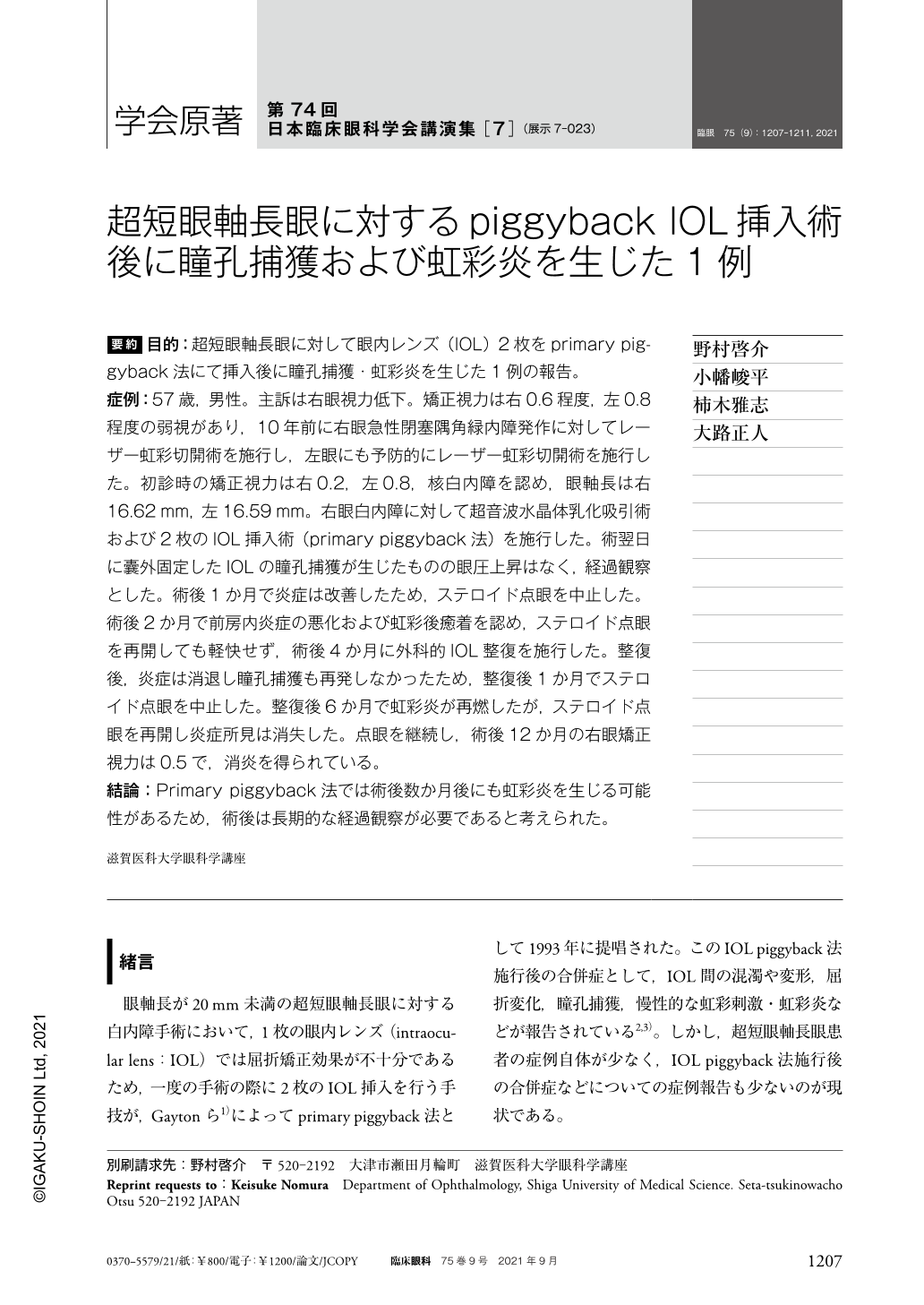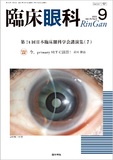Japanese
English
- 有料閲覧
- Abstract 文献概要
- 1ページ目 Look Inside
- 参考文献 Reference
要約 目的:超短眼軸長眼に対して眼内レンズ(IOL)2枚をprimary piggyback法にて挿入後に瞳孔捕獲・虹彩炎を生じた1例の報告。
症例:57歳,男性。主訴は右眼視力低下。矯正視力は右0.6程度,左0.8程度の弱視があり,10年前に右眼急性閉塞隅角緑内障発作に対してレーザー虹彩切開術を施行し,左眼にも予防的にレーザー虹彩切開術を施行した。初診時の矯正視力は右0.2,左0.8,核白内障を認め,眼軸長は右16.62mm,左16.59mm。右眼白内障に対して超音波水晶体乳化吸引術および2枚のIOL挿入術(primary piggyback法)を施行した。術翌日に囊外固定したIOLの瞳孔捕獲が生じたものの眼圧上昇はなく,経過観察とした。術後1か月で炎症は改善したため,ステロイド点眼を中止した。術後2か月で前房内炎症の悪化および虹彩後癒着を認め,ステロイド点眼を再開しても軽快せず,術後4か月に外科的IOL整復を施行した。整復後,炎症は消退し瞳孔捕獲も再発しなかったため,整復後1か月でステロイド点眼を中止した。整復後6か月で虹彩炎が再燃したが,ステロイド点眼を再開し炎症所見は消失した。点眼を継続し,術後12か月の右眼矯正視力は0.5で,消炎を得られている。
結論:Primary piggyback法では術後数か月後にも虹彩炎を生じる可能性があるため,術後は長期的な経過観察が必要であると考えられた。
Abstract Purpose:To report a case of iris capture and iritis after the insertion of two intraocular lenses(IOL)using the primary piggyback method into the eye with an extremely short axial length.
Case:A 57-year-old man presented with decreased visual acuity in the right eye. He had amblyopia with a best corrected visual acuity(BCVA)of 0.6 in the right eye and 0.8 in the left eye, and laser iridotomy was performed to correct acute angle-closure glaucoma attack 10 years ago in the right eye and prophylactically in the left eye. At his first presentation here, the BCVA was 0.2 in the right eye and 0.8 in the left eye. A nuclear cataract was apparent in both eyes. The axial length was 16.62 mm in the right eye and 16.59 mm in the left eye. Phacoemulsification and two IOL insertions(primary piggyback method)were performed in the right eye. Although iris capture of the IOL that was placed in the sulcus was performed the day after the surgery, the intraocular pressure did not increase, so IOL repositioning was not performed. The steroid eye drop was discontinued because the anterior chamber inflammation resolved one month postoperatively. The anterior chamber inflammation was reactivated and posterior synechia was observed 2 months postoperatively. Because the anterior chamber inflammation was not resolved by steroid eye drop treatment, IOL repositioning was performed 4 months after the surgery. The anterior chamber inflammation resolved, and iris capture did not recur, so the steroid eye drops ware discontinued one month after the IOL repositioning. The iritis recurred 6 months after the IOL repositioning, but the anterior chamber inflammation resolved with steroid eye drops. The eye drop was continued, and the decimal BCVA in the right eye was 0.5 12 months postoperatively, and the anterior chamber inflammation did not recur.
Conclusion:Eyes subjected to primary piggyback implantation should be carefully monitored long term because anterior chamber inflammation could occur even several months after the surgery.

Copyright © 2021, Igaku-Shoin Ltd. All rights reserved.


